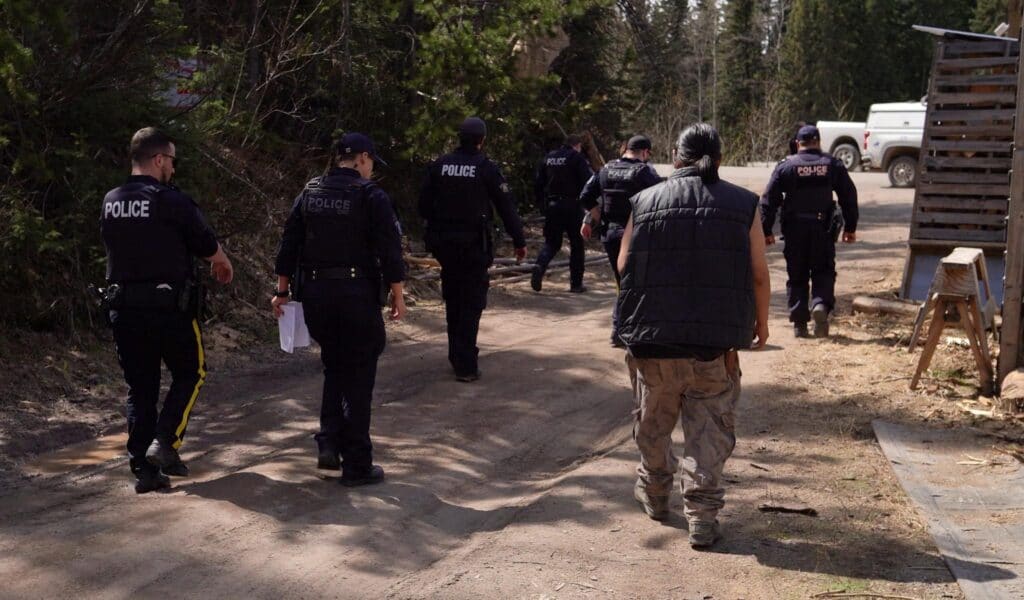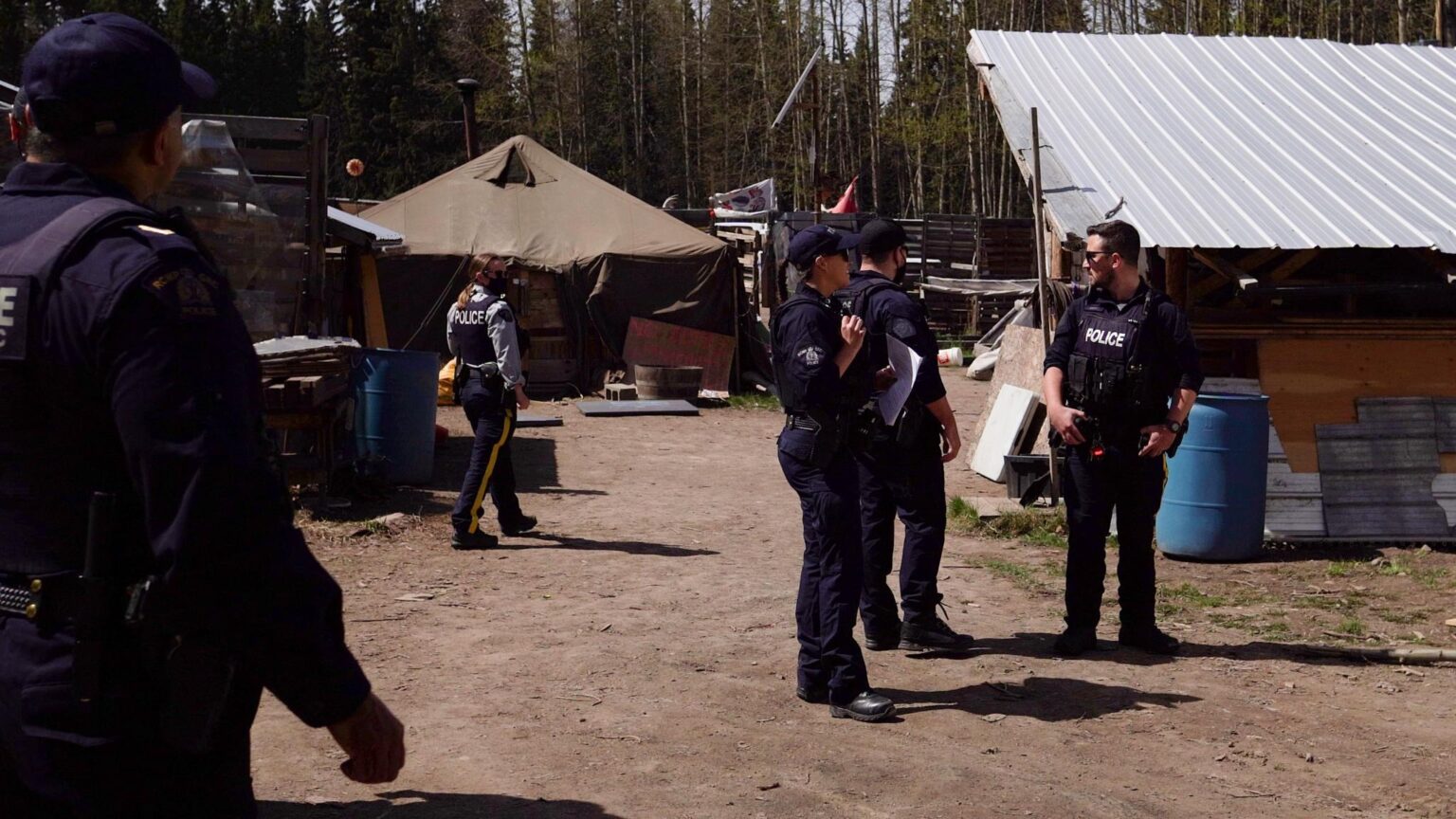Canadian police and security forces have intensified their surveillance and harassment of Indigenous people in recent months in an effort to clear the way for the construction of two long-distance oil and gas pipelines in British Columbia, earning the condemnation of international human rights observers.
“The Governments of Canada and of the Province of British Columbia have escalated their use of force, surveillance, and criminalization of land defenders and peaceful protesters to intimidate, remove and forcibly evict Secwepemc and Wet’suwet’en Nations from their traditional lands,” the United Nations Committee on the Elimination of Racial Discrimination (CERD) wrote in an April 29 letter.
It was the third time the international body reproached the Canadian federal and provincial governments for their treatment of Indigenous communities in relation to the construction of the two fossil fuel projects. The Tiny House Warriors, a group of Secwepemc people, are opposing the Trans Mountain expansion pipeline, a long-distance oil pipeline that is under construction and would run from Alberta’s tar sands to the Pacific Coast, ending near Vancouver. And Wet’suwet’en land defenders are opposing the Coastal GasLink pipeline, a fossil gas pipeline that would feed an LNG export terminal in northern British Columbia.
A 1997 Supreme Court decision affirmed Aboriginal rights to land, and both Indigenous movements fighting the two fossil fuel projects state that their physical presence on their pre-colonial lands is a way of exercising their rights. The Tiny House Warriors have constructed small mobile homes on their ancestral lands, in the path of the Trans Mountain pipeline. The Gidimt’en clan of the Wet’suwet’en has also occupied their traditional territory, building permanent homes and spiritual buildings in a heavily forested area south of the small town of Houston.
Both communities have been targeted by RCMP and private security forces, and the clashes intensified last year. In July, Trans Mountain dismantled barricades erected by Tiny House Warriors, and the company set up surveillance towers as it sought to expand a man camp for pipeline workers. In September and October, the Wet’suwet’en set up blockades on access roads, as Coastal GasLink prepared to drill beneath Wedzin Kwa (Morice River), which both is a source of food and holds spiritual significance to the Wet’suwet’en. The standoff reached a climax in November, with a militarized crackdown by the RCMP, arresting more than two dozen people.
In recent months, the surveillance and police presence have dramatically escalated yet again. According to Gidimt’en Clan of the Wet’suwet’en, the RCMP has conducted more than 225 “site inspections” since March 2022 at one of their village encampments. The Wet’suwet’en land defenders say they have been constantly surveilled, followed, and harassed. Some of the incursions happen at odd hours.
“Visits would range from one to five times within a 24 hour period. Sometimes in the middle of night,” Sleydo’ Molly Wickham, a spokesperson for the Gidimt’en Checkpoint, one of the villages on Wet’suwet’en territory, told DeSmog.
“They’ve followed me to my home. There’s also private security sitting outside Gidimt’en Checkpoint, surveilling the comings and goings of myself, my children, my family…anybody who is coming or going to the village site,” she said.
The encampments are in remote locations, down narrow forest roads, far from any urban population. “So, it’s not like these neighborhood cops just doing a patrol and checking in,” Eugene Kung, a staff attorney with West Coast Environmental Law, told DeSmog. “In order to get there, you have to deliberately want to be there.”
CERD again called for the removal of RCMP and private security from Indigenous land, the halting of construction on both projects, and a return to consultations between the governments and Indigenous nations.
“When I first read the letter, I nearly cried. Because it was validation of what we already know and what we already feel,” Sleydo’ said. “The fact that the government and industry are working so closely together to oppress us on our own territories and diminish our title and our rights, and violate basic human rights, has been an overwhelming experience. It was such a relief to hear this international body condemn those practices.”
The letter noted that Canada has signed the United Nations Declaration on the Rights of Indigenous Peoples (UNDRIP) into law, which, among other things, requires the free, prior, and informed consent of Indigenous peoples on all new energy projects. Coastal GasLink has the support of elected band leaders of the Wet’suwet’en, a system created in the 19th century by the Canadian settler government. But the project is opposed by the hereditary chiefs, and they point to the 1997 Supreme Court decision that backs up their land title. In short, the clans that oppose Coastal GasLink say that both Indigenous and Canadian law are on their side.
“Although Canada has enshrined the UN Declaration on the Rights of Indigenous Peoples (UNDRIP), they most certainly are not upholding it. They continue their tactics implemented since contact, just different wording and language,” Chief Na’Moks, the highest-ranking hereditary chief of the Tsayu (Beaver Clan) of the Wet’suwet’en Nation, said in a statement. “To truly uphold UNDRIP, they must show the honor of the Crown. There is no honor in their continued use of force when Indigenous Nations do not agree with their decisions.”
Another day, another pair of harassment stops from @BCRCMP CIRG officers at our village site. This unit exists solely to force through industrial mega-projects on unceded lands where sovereign Indigenous people have said NO! @jjhorgan call off your goons. #rcmpofftheyintah
— Gidimt’en Checkpoint (@Gidimten) May 21, 2022
8 @rcmpgrcpolice trespassed today. They disrupted the work at our balhats (feast hall) build before moving onto a home site where they went to areas where we eat & our children play. What if you were being surveilled in your home @jjhorgan? This is our land.#RCMPofftheYintah
— Gidimt’en Checkpoint (@Gidimten) May 22, 2022
But Canada appears to be ignoring the calls from the international human rights body. “It is significant and concerning that Canada would not respond substantively to these letters,” Kung said, referring to the CERD documents. “Canada has signed and ratified the International Convention on the Elimination of All Forms of Racial Discrimination, which is where this CERD body comes from. In terms of international law and domestic law, ratification of an international treaty is basically as formal as it gets.”
In response to questions from DeSmog, the Permanent Representative of Canada to the United Nations Office in Geneva, to whom the CERD letter was addressed, referred questions to the Department of Canadian Heritage, who did not respond. The provincial government of British Columbia also did not respond.
Injunctions and ‘Counterinsurgency’
In early June, BC provincial prosecutors said they would move forward with criminal charges against 15 of the 27 individuals arrested last fall, including during the November 2021 raid on Wet’suwet’en territory. The arrested included Indigenous land defenders, as well as legal observers and journalists, although the charges against the journalists were dropped. In July, prosecutors are expected to decide on further criminal charges against another 10 people.
One of the main legal tools that Coastal GasLink and Trans Mountain Corporation have been using against Indigenous land defenders is the injunction, a court order that results in a geographic exclusion zone around the construction project. Once the company has an injunction in hand, then it can turn to the RCMP to arrest land defenders for violating the order.
But Indigenous people and other experts say the injunction is weaponized against land defenders and is being used to remove them from their unceded traditional territory to allow oil and gas projects to proceed there.
A 2019 study by the Yellowhead Institute, an Indigenous-led think tank, found evidence to back that up. The group reviewed more than 100 injunctions spanning several decades in Canada, nearly all of which related to resource extraction. Who was filing the injunction often predicted its success. Courts granted more than 80 percent of injunctions filed by corporations against First Nations. However, when the circumstances were reversed — when a First Nation filed an injunction against a corporation — more than 80 percent were denied.
“[T]he courts expect First Nations to commit to lengthy, costly litigation to secure protection for their lands and waters. But companies can more or less get injunctions if there is any whiff of economic loss,” a 2019 Yellowhead Institute report on Indigenous land dispossession stated. The late Arthur Manuel, a prominent Secwepemc leader and international Indigenous rights activist, once referred to the use of injunctions as a “legal billy club.”
“The injunction has proved to be a moveable feast for corporations seeking to remove Indigenous people from their homelands,” Shiri Pasternak, one of the researchers on the Yellowhead Institute report and now an assistant professor of criminology at Toronto Metropolitan University, told DeSmog. Corporations are able to use this legal tool wherever and whenever they find themselves on Indigenous land, she said.
Ahead of the November 2021 raid that resulted in the arrest of more than dozen people, TC Energy, apparently unsatisfied with the RCMP’s enforcement of the injunction around the Coastal GasLink site, sent emails to RCMP leadership, according to The Narwhal. The company warned that it would go to court to compel the RCMP to act if the police force didn’t take stronger action.
“This is demonstrably a high-level coordination effort between the federal and provincial governments, the pipeline company, and the RCMP,” Pasternak said.

The approach by the RCMP and the Canadian governments towards Indigenous people opposing oil and gas pipelines should be viewed through a “counterinsurgency” lens, Miles Howe, an assistant professor at Ontario-based Brock University, told DeSmog.
Howe co-authored a peer-reviewed paper published in the Canadian Journal of Sociology in 2018 that revealed a secret database and investigation run by the RCMP in response to Idle No More, an Indigenous rights movement that swept the country in 2013, as well as to anti-fracking protests in Canada’s maritime provinces of Nova Scotia and New Brunswick the same year. The RCMP intelligence program, dubbed “Project Sitka,” included a socio-psychological profiling matrix that plugged in data on individuals, ranking them in terms of their potential threat level.
“What was very interesting was almost none of the risk factors were related to aspects of potential future criminality,” Howe said, referring to the metrics used by the RCMP program. Instead, individuals were deemed to be bigger threats if they were “successful” at spreading their message and building support for their cause.
“If you’re telegenic, if you looked good on camera, if you had social media acumen, if you had a lot of followers, if the issue was something where you could break it down into slogans…those would get you scored,” Howe said. The metrics used to rank threat level were “not criminal,” he said, but instead seemed aimed at identifying people who might pose obstacles to projects backed by the state, which mostly related to resource extraction.
Howe said it was a kind of “pre-crime” program that resulted in surveillance of Indigenous people and anti-fracking protesters. He found that the RCMP flagged more than 300 people initially, and then whittled it down to 89, of which 45 were anti-fracking protesters that were from Nova Scotia and New Brunswick, where some of the high-profile protests occurred.
Howe saw a lot of overlap from his research on the RCMP program from several years ago and the surveillance and intimidation of the Wet’suwet’en and Secwepemc land defenders today. Indeed, the CBC reported that the RCMP reactivated Project Sitka just days before Prime Minister Justin Trudeau approved the Trans Mountain expansion in November 2016.
“The Maritimes got quiet, Wet’suwet’en got hot,” Howe said. “There’s nothing to say that this list is not still active.”
An in-depth investigation from APTN News published on June 16 reveals details on the secret unit of the RCMP, the Community-Industry Response Group(C-IRG), set up years ago with the aim of surveilling opposition to the Trans Mountain expansion and Coastal GasLink.
Turning back to the counterinsurgency concept, Howe said much of the work to neutralize Indigenous rights movements goes beyond violent raids, which understandably grab much of the attention. “It’s a bunch of moving pieces. It’s media, it’s politicians, it’s academics, it is the state security bodies. But it’s not just the police,” Howe said. “There’s a whole lot of effort going into justifying what the police will then have to do to ‘restore order’ or whatever the narrative is.”
Pasternak saw it in similar terms. She said that the surveillance and harassment of Indigenous people should be thought of as part of Canada’s long history of colonial settlement. “This is the blueprint of Canada, so much so that sometimes I think of Canada sometimes more as a company than a country,” she said.
The constant RCMP presence is “pure harrassment and psychological intimidation,” Sleydo’ said. “They are creating the conditions where it’s unbearable to live on our territories.”
The RCMP did not respond to questions from DeSmog.
Pipeline Expansion Incompatible with Climate Goals
The Trans Mountain pipeline expansion was nationalized by the Canadian government in order to keep it alive in 2018, after Kinder Morgan, the former owner, moved to cancel it due to ballooning costs and legal uncertainty around conflict with First Nations. Since then, costs have exploded to new heights. Earlier this year, Trans Mountain said the price tag could reach C$21.4 billion, nearly double the cost expected two years earlier and a several-fold increase over the original estimate.
The boondoggle has increasingly become a political liability, and the federal government said it would not offer further public funding for the pipeline. However, the government provided a $10 billion loan guarantee in order to enlist Canada’s largest banks into funding another tranche of capital, allowing construction to continue.
For years, Canadian Prime Minister Justin Trudeau has championed both Coastal GasLink and the Trans Mountain expansion — and his government directly owns Trans Mountain — and there is little evidence that the CERD letter will cause the federal or provincial governments to change course.
It’s not clear what impact the international human rights body’s letter will have, but it “puts pressure on Canada because Canada likes to project itself as a great human rights advocate and protector around the world. And Canada’s reputation has been harmed in recent years,” Pasternak of Toronto Metropolitan University said. “They know that even though they are denying Indigenous rights domestically, that international human rights recognizes Indigenous rights to self-determination.”
On June 6, fifty-seven civil society organizations sent a letter to Canadian Prime Minister Justin Trudeau and BC Premier John Horgan, calling on them to remove police and RCMP forces from the Indigenous territories through which the two pipelines are being built.
“Both the federal and British Columbia governments regularly express their dedication to both climate action and reconciliation, yet undermine both by condoning the ongoing violence against Indigenous land defenders,” the letter states. “Climate action cannot be separated from the broader project of Indigenous self-determination and decolonization.”
Update: 6/23/2022: Canadian Heritage responded to DeSmog on June 22, stating in part that it is “currently coordinating the preparation of a response to the latest communication the Government of Canada received from the CERD… on the situation of the Secwepemc and Wet’suwet’en communities in British Columbia in relation to the Trans Mountain Pipeline and Coastal Gas Link Pipeline,” but added that the response “will remain confidential until final views are published by the Committee.” A spokesperson for the Ministry of Public Safety and Solicitor General for the government of British Columbia also sent a response to DeSmog on June 22 that stated in part, “Enforcement action by the RCMP in response to a court decision is an operational matter for the RCMP and is entirely at arm’s length from government. The RCMP must enforce a B.C. Supreme Court injunction order if directed to do so by the court.”
Subscribe to our newsletter
Stay up to date with DeSmog news and alerts







